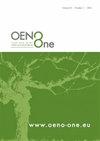Sensory and aroma impact of mitigation strategies against sunburn in Riesling
IF 2.2
3区 农林科学
Q3 FOOD SCIENCE & TECHNOLOGY
引用次数: 0
Abstract
Climate change is an environmental challenge that impacts the wine industry due to frequent sunburn damage triggered by heat waves, sun radiation and severe water deficits. This leads to severe yield losses and sensory changes in the resulting wines, presumably caused by climate-induced off-flavours. This study aims to develop viticultural and oenological strategies to mitigate sunburn damage in the highly sensitive variety Riesling and its detrimental sensory properties. In 2020, we combined the timing and intensity of defoliation measures with the application of kaolin and calcium hydroxide suspensions, reflecting a portion of the solar radiation. Seven treatments were replicated in three field experiments. Grapes from each field replication were maintained as a fermentation replication and, therefore, separately vinified following a standardised protocol. Replicates, including field and fermentation replicates, were further used as sensory replications. Descriptive analysis (DA) and temporal dominance of sensations (TDS) revealed a significant sensory impact of experimental trials in eight of twelve attributes. Additionally, wines were analysed by gas chromatography-mass spectrometry. The early sun exposition treatment with partial defoliation of the grape zone after flowering, followed by a second defoliation at berry closure, reduced fruity aroma but increased smoky notes due to enhanced 4-vinylguajacol formation as well as the intensity of the atypical ageing note (ATA) reminiscent of acacia blossom, naphthalene and fusel alcohols. Applying kaolin or calcium hydroxide particles on the berry skin slightly mitigated these unpleasant effects and even increased fruitiness and sweetness. Late defoliation at berry closure diminished the green note, which was most prominent in the non-defoliated control. Further smokiness and ATA intensities were lowered, in contrast to their rise due to early defoliation. However, late defoliation increased 1,1,6-trimethyl-1,2-dihydronaphthalene (TDN), causing the petrol off-flavour. TDS analysis revealed a higher fruity and sweet dominance during the first 10 seconds due to early defoliation, while late defoliation fostered dominant and lingering sourness. In conclusion, early defoliation, which lowers sunburn incidence due to an early adaptation towards sun exposure, increases smoky and ATA flavours and diminishes fruitiness. These detrimental sensory effects could be significantly mitigated by applying reflecting particles of kaolin and calcium hydroxide on berry skins.雷司令抗晒伤策略对感官和香气的影响
由于热浪、太阳辐射和严重缺水引发的频繁晒伤,气候变化是影响葡萄酒行业的环境挑战。这会导致严重的产量损失和葡萄酒的感官变化,可能是由气候引起的异味引起的。本研究旨在制定葡萄栽培和酿酒策略,以减轻高敏感品种雷司令的晒伤损害及其有害的感官特性。2020年,我们将落叶措施的时间和强度与高岭土和氢氧化钙悬浮液的应用结合起来,反映了部分太阳辐射。7个处理在3个田间试验中重复。葡萄从每个领域复制保持发酵复制,因此,按照标准化的协议单独酿造。重复,包括田间重复和发酵重复,作为感官重复。描述性分析(DA)和感觉的时间优势(TDS)揭示了实验试验对12个属性中的8个属性的显著感觉影响。此外,还采用气相色谱-质谱法对葡萄酒进行了分析。在开花后的葡萄区进行早期日照处理,在浆果闭合时进行第二次落叶处理,减少了水果香气,但增加了烟熏味,这是由于4-乙烯基瓜木酚的形成增强了,以及非典型陈年味(ATA)的强度,让人想起金合欢花、萘和杂醇酒。在浆果皮上涂上高岭土或氢氧化钙颗粒可以轻微减轻这些不愉快的影响,甚至可以增加果味和甜味。果实闭合时晚落叶降低了绿调,这在未落叶对照中最为明显。烟害和ATA强度进一步降低,与早期落叶造成的上升形成对比。然而,晚去叶增加了1,1,6-三甲基-1,2-二氢萘(TDN),导致汽油变质。TDS分析显示,由于早期落叶,前10秒果实和甜味优势较高,而后期落叶则形成优势和挥之不去的酸味。总之,由于早期适应阳光照射,早期落叶降低了晒伤发生率,增加了烟熏味和ATA味,减少了果味。在浆果皮上施用高岭土和氢氧化钙反射颗粒可以显著减轻这些有害的感官影响。
本文章由计算机程序翻译,如有差异,请以英文原文为准。
求助全文
约1分钟内获得全文
求助全文
来源期刊

OENO One
Agricultural and Biological Sciences-Food Science
CiteScore
4.40
自引率
13.80%
发文量
85
审稿时长
13 weeks
期刊介绍:
OENO One is a peer-reviewed journal that publishes original research, reviews, mini-reviews, short communications, perspectives and spotlights in the areas of viticulture, grapevine physiology, genomics and genetics, oenology, winemaking technology and processes, wine chemistry and quality, analytical chemistry, microbiology, sensory and consumer sciences, safety and health. OENO One belongs to the International Viticulture and Enology Society - IVES, an academic association dedicated to viticulture and enology.
 求助内容:
求助内容: 应助结果提醒方式:
应助结果提醒方式:


